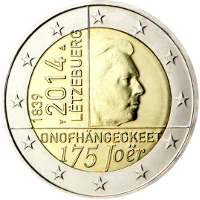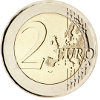 |
C o m m e m o r a t i v e
C o i n s |
||
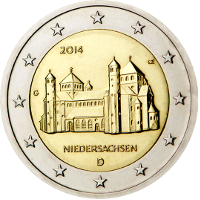 🔎
🔎 |
 |
Germany | 06 Feb. 2014 | Lower Saxony (St. Michael's church in Hildesheim) 9th coin in the Federal States series |
20001 20002 20005 |
30,799,300 |  |
‐ ‐ Lower Saxony's coin motif was originally intended to be the New Town Hall in Hanover. |
|||||||
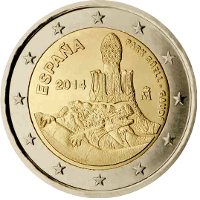 🔎
🔎 |
 |
Spain | 07 Feb. 2014 | Works of Antoni Gaudi (Park Güell) 5th coin in the UNESCO World Heritage Sites series |
20001 20002 20005 |
4,000,000 |  |
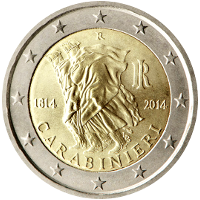 🔎
🔎 |
 |
Italy | 25 Mar. 2014 | 200th anniversari of the Carabinieri |
20001 20002 20005 |
6,525,000 |  |
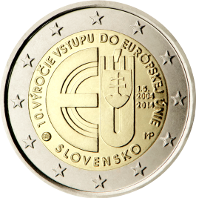 🔎
🔎 |
 |
Slovakia | 01 Apr. 2014 | 10th anniversary of the Slovak membership of the European Union |
20001 20002 20005 |
1,000,000 |  |
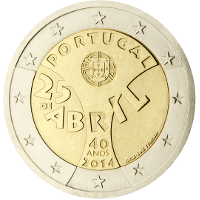 🔎
🔎 |
 |
Portugal | 23 Apr. 2014 | 40th anniversary of the Carnation Revolution |
20001 20002 20005 |
520,000 |  |
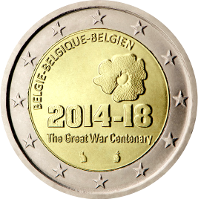 🔎
🔎 |
 |
Belgium | 12 May 2014 | 100th anniversary of the outbreak of the Great War |
20001 20002 20005 |
1,712,000 |  |
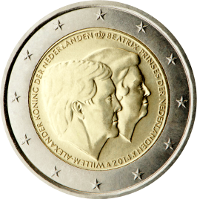 🔎
🔎 |
 |
Netherlands | 22 May 2014 | The official farewell to the former Queen Beatrix |
20001 20002 20004 20005 |
5,291,000 |  |
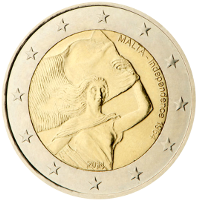 🔎
🔎 |
 |
Malta | 03 Jun. 2014 | Independence from Great Britain in 1964 4th coin of the Constitutional History series |
20001 20002 20005 |
432,500 |  |
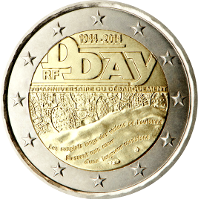 🔎
🔎 |
 |
France | 11 Jun. 2014 | 70th anniversary of the D‐Day Landings (June 6th 1944) |
20001 20002 20005 |
3,019,675 |  |
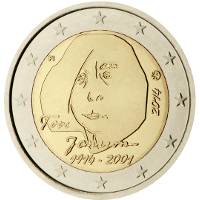 🔎
🔎 |
 |
Finland | 16 Jun. 2014 | 100th birthday of Tove Jansson |
20001 20002 20005 |
1,500,000 |  |
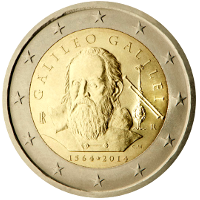 🔎
🔎 |
 |
Italy | 17 Jun. 2014 | 450th birthday of Galileo Galilei |
20001 20002 20005 |
6,529,820 |  |
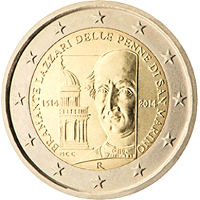 🔎
🔎 |
 |
San Marino | 23 Jun. 2014 | 500th anniversary of the death of Donato Bramante |
20001 20002 20005 |
114,000 |  |
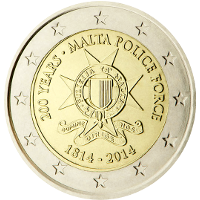 🔎
🔎 |
 |
Malta | 16 Jul. 2014 | 200th anniversary of the Malta Police Force |
20001 20002 20005 |
300,000 |  |
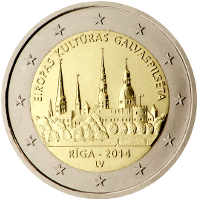 🔎
🔎 |
 |
Latvia | 12 Aug. 2014 | Riga, European Capital of Culture 2014 |
20001 20002 20005 |
1,005,000 |  |
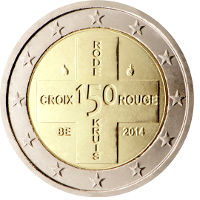 🔎
🔎 |
 |
Belgium | 18 Sep. 2014 | 150th anniversary of the Belgium Red Cross |
20001 20002 20005 |
287,500 |  |
 ) or
the Dutch version (GOD ⋆ ZIJ ⋆ MET ⋆ ONS ⋆) instead of the normal
Belgian edge inscription ( ) or
the Dutch version (GOD ⋆ ZIJ ⋆ MET ⋆ ONS ⋆) instead of the normal
Belgian edge inscription ( ). ). |
|||||||
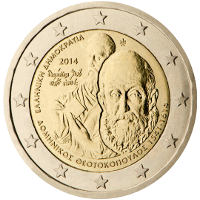 🔎
🔎 |
 |
Greece | 24 Sep. 2014 | 400th anniversary of the death of Dominikos Theotokópoulos |
20001 20002 20005 |
750,000 |  |
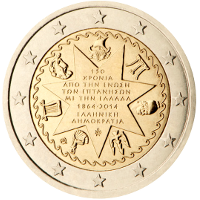 🔎
🔎 |
 |
Greece | 24 Sep. 2014 | 150th anniversary of the Union of the Ionian Islands with Greece |
20001 20002 20005 |
750,000 |  |
 🔎
🔎 |
 |
San Marino | 29 Sep. 2014 | 90th anniversary of the death of Giacomo Puccini |
20001 20002 20005 |
100,000 |  |
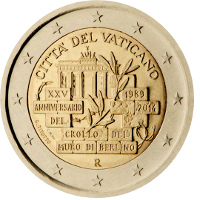 🔎
🔎 |
 |
Vatican City | 14 Oct. 2014 | 25th anniversary of the collapse of the Berlin Wall |
20001 20002 20005 |
103,000 |  |
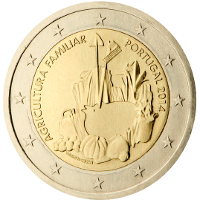 🔎
🔎 |
 |
Portugal | 31 Oct. 2014 | International Year of Family Farming |
20001 20002 20005 |
520,000 |  |
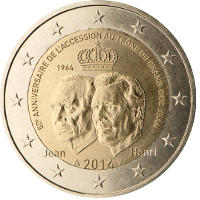 🔎
🔎 |
 |
Luxembourg | 06 Nov. 2014 | 50th anniversary of Grand Duke Jean's accession to the throne 13th coin of the Grand-Ducal Dynasty series |
20001 20002 20005 |
512,000 |  |
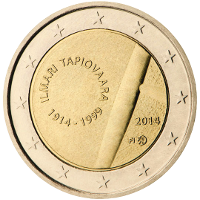 🔎
🔎 |
 |
Finland | 10 Nov. 2014 | 100th birthday of Ilmari Tapiovaara |
20001 20002 20005 |
1,000,000 |  |
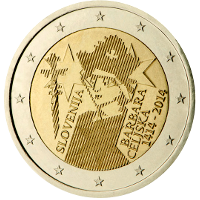 🔎
🔎 |
 |
Slovenia | 17 Nov. 2014 | 600th anniversary of the Coronation of Barbara of Celje |
20001 20002 20005 |
1,000,000 |  |
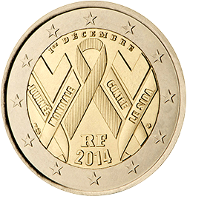 🔎
🔎 |
 |
France | 24 Nov. 2014 | World‐AIDS‐Day |
20001 20002 20005 |
3,020,000 |  |
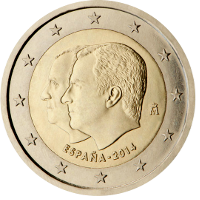 🔎
🔎 |
 |
Spain | 10 Dec. 2014 | King Felipe VI's accession to the thone |
20001 20002 20005 |
8,132,500 |  |
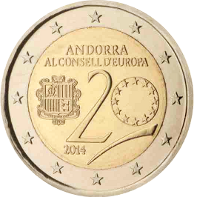 🔎
🔎 |
 |
Andorra | 29 Feb. 2016 | 20th anniversary of Membership to the Council of Europe |
20001 20002 20005 |
105,000 |  |
| ⇓ 2015 ⇓ |
| References : | |||
| 20001 | Images taken with authorisation by the ECB - Mail dated 20.Feb.2020 © "European Central Bank" |
20002 | Data mirrored from Wikipedia Page "2_euro_commemorative_coins" with friendly support of the guardians of that page. |
| 20003 | Not Applicable | 20004 | Coloured version of this Commemorative Coin in circulation EU-legal-technical specifications do not recongnise colour prints, but the EU is tolerate them, due to the facts that their numbers are very small and that they are sold in special packs and therefor are very unlikely to be used as currency. |
| 20005 | enlarged Images taken with authorisation by Gerd Seyffert © "Gerd Seyffert 2021" |
20006 | Not Applicable |
 |
